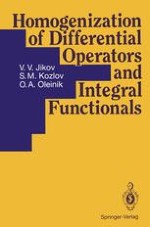1994 | OriginalPaper | Buchkapitel
Homogenization and Percolation
verfasst von : V. V. Jikov, S. M. Kozlov, O. A. Oleinik
Erschienen in: Homogenization of Differential Operators and Integral Functionals
Verlag: Springer Berlin Heidelberg
Enthalten in: Professional Book Archive
Aktivieren Sie unsere intelligente Suche, um passende Fachinhalte oder Patente zu finden.
Wählen Sie Textabschnitte aus um mit Künstlicher Intelligenz passenden Patente zu finden. powered by
Markieren Sie Textabschnitte, um KI-gestützt weitere passende Inhalte zu finden. powered by
The phenomenon of percolation can be conveniently modeled by a random structure of chess-board type, or random checkered tessellation. A structure of this kind is obtained if we split the plane into squares, painting each square, independently, black or white with probability p or 1 − p, respectively, where 0 ≤ p ≤ 1. Then the union of all black squares forms a random set F. Any two black squares are thought of as neighboring, or linked, if they have a common side or a vertex. In accordance with this arrangement, a finite number of black squares is said to form a path if these squares can be enumerated in such a way that any two consecutive numbers correspond to neighboring or linked squares. A set K consisting of black squares is connected if for any pair of squares belonging to K there exists a path containing these squares and belonging to K. Obviously, the set F is a union of separate connected components, which are called clusters.
